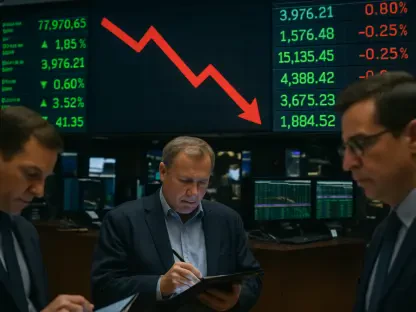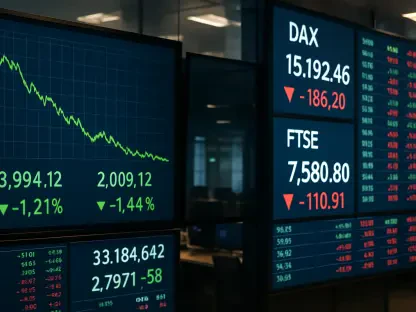The recent confidence expressed by Morgan Stanley in U.S. stocks and bonds arises amidst an environment of uncertainty and mixed investor sentiment globally. The assertion that American financial assets will outperform their global counterparts contradicts a prevailing “sell America” attitude fueled by apprehensions regarding a new spending bill’s impact on the federal deficit. With the S&P 500 dipping around 1% alongside a noticeable 10-basis-point increase in the 10-year Treasury yield, concerns have intensified. However, Morgan Stanley remains optimistic, invoking the “TINA” principle—asserting that viable investment alternatives are scarce at present.
Factors Driving Optimism in U.S. Financial Markets
Expectations for Stable Stock Market Appreciation
Morgan Stanley’s anticipation of a U.S. stock market upswing is driven by several key factors expected to override current volatility. Central to this outlook is the expectation of Federal Reserve rate cuts that are likely to stimulate economic activities and investments. A weakening U.S. dollar also plays a crucial role, making American commodities and equities more attractive on an international scale. Additionally, the firm underscores the potential of AI-driven efficiency gains, which are predicted to spur robust productivity growth. The projection that the S&P 500 could ascend to 6,500 within the next year—a 10% increase from current levels—illustrates substantive faith in market resilience.
Moreover, easing trade tensions, which have historically caused fluctuations in markets, have been instrumental in stabilizing investor outlooks. The earlier apprehensions of regressing to April market lows are being curtailed by improved diplomatic engagements and policies that foster international trade cooperation. This stable backdrop enables Morgan Stanley to assert that American stocks, under these supportive conditions, are poised to capitalize on forthcoming economic recoveries and technological advancements.
Bond Market Dynamics and Projections
In the bond market, Morgan Stanley’s view diverges from the recent uptick in 10-year Treasury yields, labeling it as a temporary phenomenon. They foresee range-bound trading extending to year-end, postulating that anticipated rate cuts in the forthcoming year will drive yields down. Specifically, the 10-year yield is expected to taper to 3.45% by mid-2026. This stance is bolstered by a broader belief that fears of a large-scale shift away from U.S. financial assets are overstated.
Foreign holdings of U.S. dollar-denominated bonds have surged to unprecedented levels, demonstrating sustained international interest in the stability and quality of American financial instruments. This trend reflects global investors’ confidence in the resilience of the U.S. financial framework. Despite periodic tremors, the overarching sentiment remains favorable towards U.S. bonds, underscoring a continued allegiance to high-grade American investments. Morgan Stanley’s prognosis thus highlights the potential for U.S. capital markets to retain an edge over global peers, even in an escalating interest rate environment.
The Bigger Implications for Investors
Navigating Economic Fluctuations
Amidst global economic shifts, Morgan Stanley suggests that U.S. financial markets present a relatively secure haven for investors. The dynamics of anticipated rate cuts and a resilient stock market are posited as pivotal reasons for this optimism. The influential role of AI and technological advancements in driving efficiency gains cannot be overstated, with industries increasingly adopting innovations that boost productivity. These elements collectively position U.S. stocks and bonds as attractive opportunities within the international investment landscape. Investors are encouraged to look beyond short-term fluctuations and focus on the potential for sustained growth driven by strategic economic policies and technological progression.
The broader picture also underscores the interplay of global economic factors and their influence on investment decisions. Morgan Stanley’s analysis emphasizes the importance of understanding these dynamics and adapting investment strategies accordingly. The interconnectedness of global markets necessitates a nuanced approach that considers both local and international developments. As such, investors are advised to remain vigilant yet optimistic, capitalizing on opportunities presented by changing economic landscapes and technological innovations.
Strategic Positioning for Future Growth
Amidst a global landscape of market uncertainty and mixed sentiments among investors, Morgan Stanley has recently shown confidence in U.S. stocks and bonds. This stance contrasts sharply with the widespread “sell America” mentality prevalent among many investors who worry about the impact of new spending bills on the federal deficit. The sentiment of potential American financial asset underperformance has been bolstered by a roughly 1% decline in the S&P 500 and a notable 10-basis-point rise in the 10-year Treasury yield, which has amplified concerns about financial stability. Despite these market dynamics, Morgan Stanley remains optimistic, emphasizing the “TINA”—there is no alternative—principle. They argue that given the current market conditions, attractive investment alternatives outside the U.S. are minimal, making American financial assets relatively appealing. This underscores Morgan Stanley’s belief in the resilience and inherent value of U.S. financial markets even in turbulent times.









